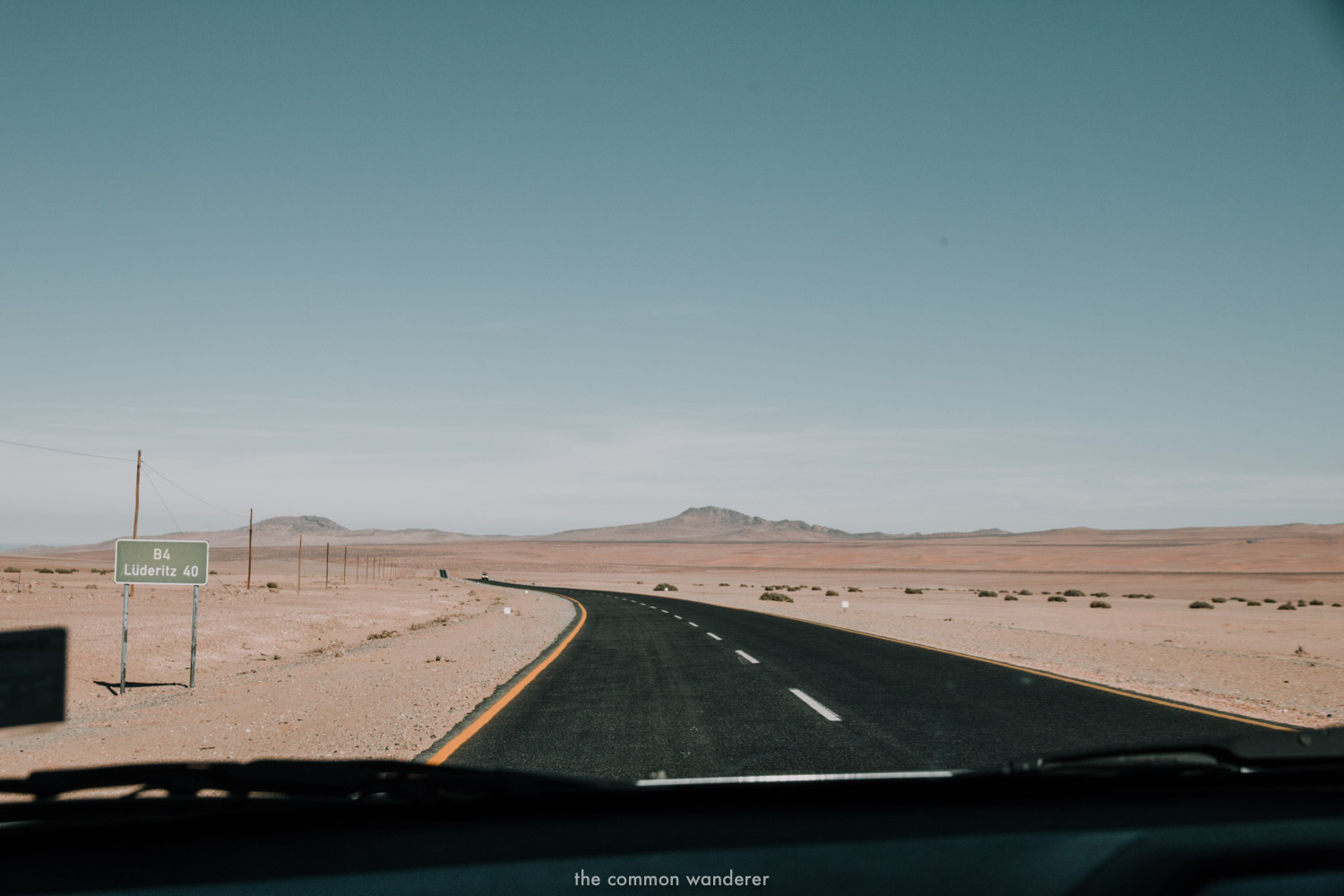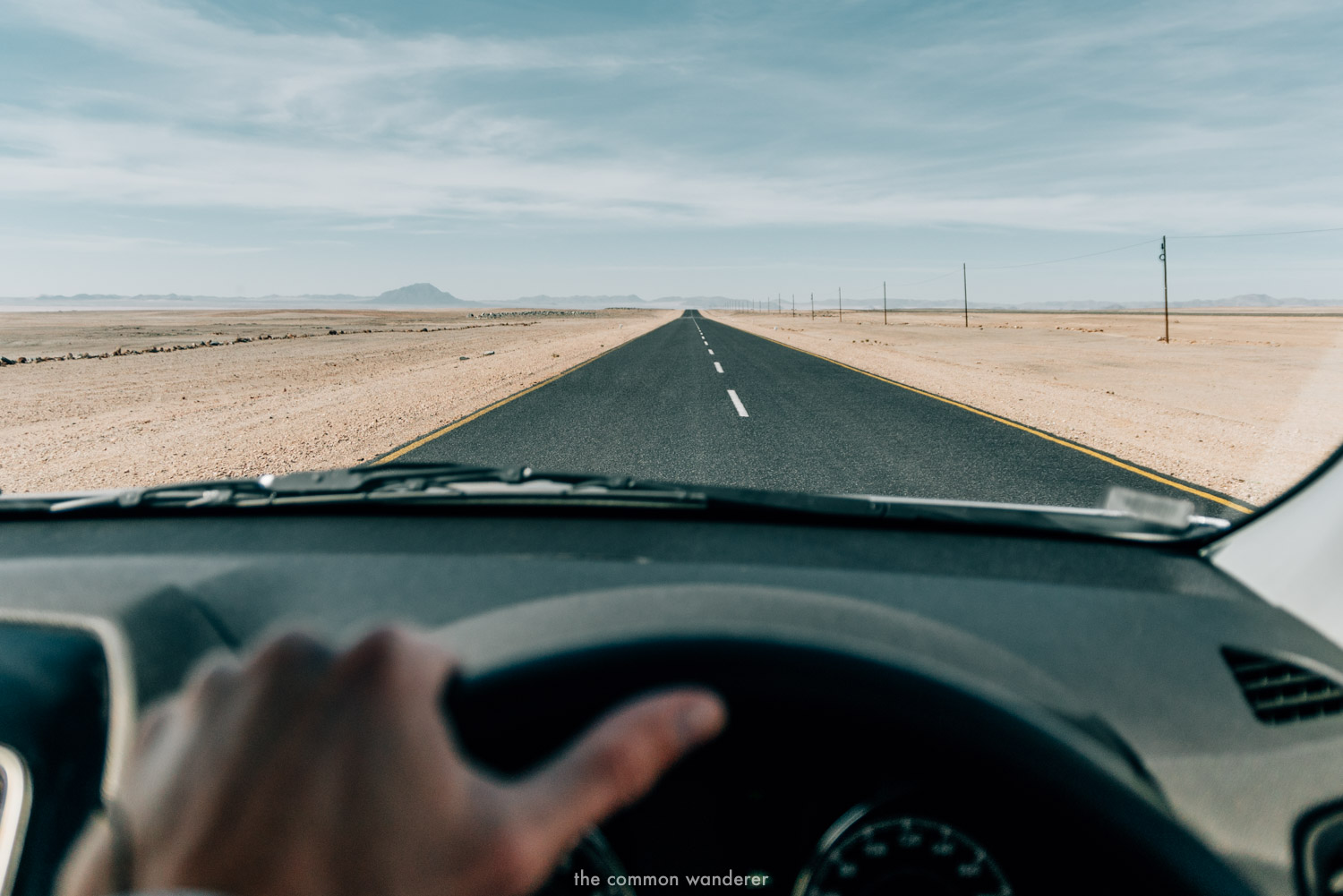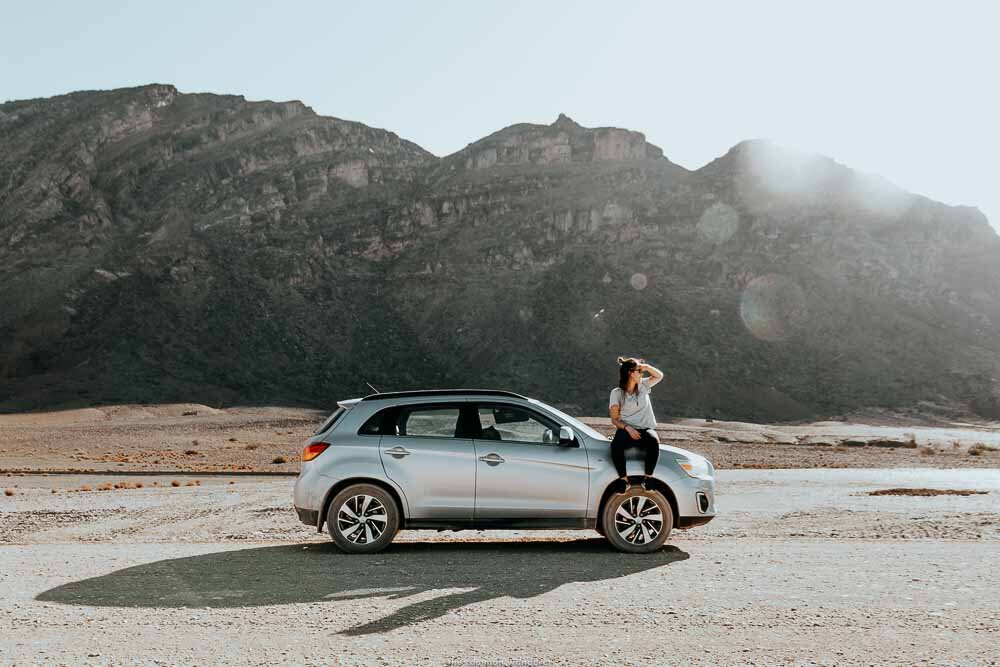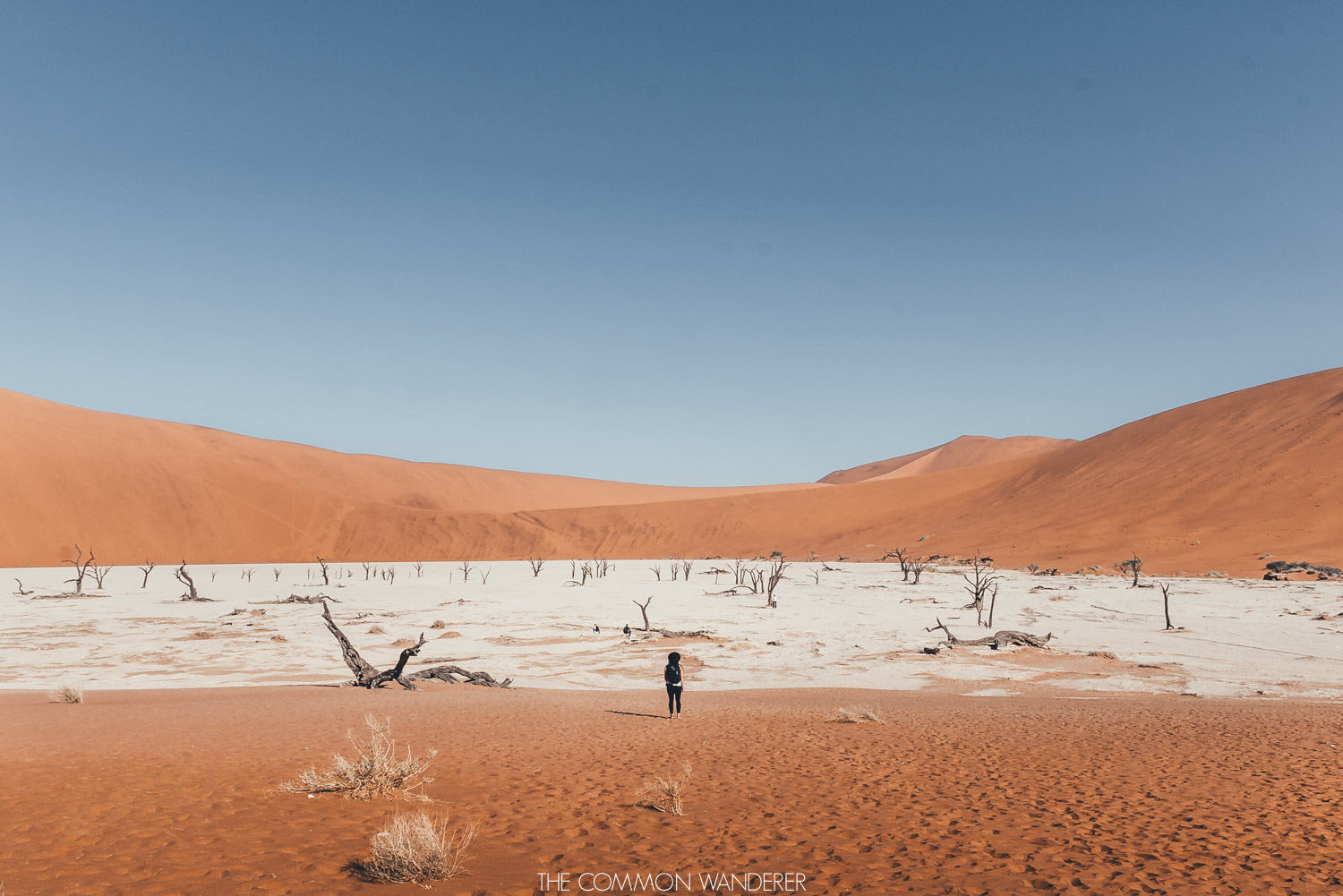A guide to driving in Namibia: 14 useful Namibia road trip tips
Driving in Namibia for the first time can be daunting - there's a lot to know and be aware of. We've put together a comprehensive list of everything we learnt on our Namibia road trip, so you can have the best and safest experience possible.
Dunes, safaris, mountains, canyons, ghost towns, big towns, small towns; driving in Namibia is an incredible way to experience this unique and utterly beautiful country.
On our Namibia road trip, we explored the country, bottom to top, traversing across some of the best and worst roads we've ever encountered. It was a real challenge, but we survived, only just (that's a story for another day!).
For a first-timer, driving in Namibia can be tough; there's a lot to know and be aware of.
That's why we've put together a comprehensive list of our top tips for driving in Namibia - to help you have the best Namibian road trip experience possible.
14 ESSENTIAL TIPS BEFORE DRIVING IN NAMIBIA
-
#1 HIRE A 4x4 IN NAMIBIA, JUST TO BE SAFE
A question most people ask is "do I need a 4x4 for Namibia?". Technically, no.
The road system in Namibia, save for the most remote locations, is comprised of well maintained tarred or gravel roads and most of the main tourist sites can be reached without a 4x4 specifically (but something robust is recommended).
We managed to drive most of the country with our all-wheel-drive Mitsubishi ASX with only one scary situation - a very sandy road in between Fish River Canyon and Sossusvlei.
We do however recommend you hire a 4x4, and specifically a 4x4 camper, and go for the option with unlimited mileage. A 4x4 vehicle makes driving in Namibia so much more comfortable.
You're higher up, so clearance is never an issue, and the larger tyres provide much more grip when driving on gravel or sand roads, great for when visiting Sossusvlei and Deadvlei, Etosha National Park, and anywhere along the Skeleton Coast. The 4x4 campers are also a great way to save money, as you can sleep in the tent above your vehicle, and use the cooking equipment housed within the vehicle.
BOOK | Rent your 4x4 via Rentalcars.com, our go-to for car rental globally
Driving in Namibia tip | Definitely hire a 4x4, it'll make your experience a whole lot better.
-
2. RENT AND DROP OFF YOUR VEHICLE IN WINDHOEK
This might sound obvious, but we recommend you rent and drop off your vehicle in Windhoek. Why? Because if you take your vehicle across borders, you'll be slugged with cross-border charges which can end up increasing the overall cost of your trip.
Crossing into Namibia from neighbouring countries will cost N$295 (as at 05/12/20109), payable when entering Namibia. As far as we're aware, this needs to be paid in cash, so be prepared. You will also need the applicable documentation including:
Valid passport of the driver
Certified copy of the vehicle registration papers
Letter of authority from the registered owner/hire company
Motor insurance certificate - obtainable at the border free of charge
If coming from South Africa, a ZA sticker
For more information, click here.
Another large cost to look out for is a one-way, cross-country fee from your rental agency. We learnt this the hard way having hired our car from Cape Town to Windhoek. Unfortunately, we were not notified of this fee upon hiring and ended up having to pay a fee of $200 USD.
BOOK | Rent your 4x4 via Rentalcars.com, our go-to for car rental globally
Driving in Namibia tip | Hire and drop off your vehicle in Windhoek, and avoid taking across borders if possible.
visiting namibia? here are our top namibia travel tips to make your journey safe
-
3. DISTANCES ARE LONG, DRIVE TIMES EVEN LONGER
Namibia isn't known as the land of endless horizons for nothing - it's vast! In fact, Namibia has the second lowest population density in the world after Mongolia, with only 2.2 million inhabitants. On one day, we spent several hours driving through the Namib desert without seeing another living soul - not even an animal.
Therefore, it's important to note that distances are long. Drive times can be even longer when you account for the gravel/sandy roads which you're likely to encounter.
Driving in Namibia tip | Add an hour or two to any travel time that doesn't include tarred roads
-
#4 DON'T SPEED, ESPECIALLY ON GRAVEL ROADS
Namibian roads are long and empty so it can be tempting to speed. Don't.
The answer might be obvious, but we can't emphasise enough the importance of sticking to the road rules. If you're unlucky enough to have an accident, it may be hours/days until someone finds you, and if you're severely injured, medical help may be hours away.
Speed limits in Namibia are as follows:
Tarred roads | 120 km/h
Gravel roads | 80 km/h
Urban areas | 50-60 km/h
The penalties for exceeding the local speed limits are extremely severe, and law enforcement is wide-spread.
The roads in Namibia vary in condition - some tarred roads are excellent (those labelled with the letter 'B' on maps), while some gravel roads ('D' or 'C' prefixes on maps) turn to sand very quickly and can result in accidents. Punctures are also a possibility on gravel roads (we can't tell you how many we saw) and speed may increase the likelihood.
Driving in Namibia tip | Don't speed, ever!
a journey through barren lands - enjoy our namibia photo journey
-
#5 HAVE THE RIGHT DRIVING LICENCE
To hire a car in Namibia you must be 23 years or older, and have held your full licence for at least 1 year, however, this does depend on the supplier, and we've generally found the driver must be 25 years of age or more. Those between 21-25 may be required to pay an additional insurance fee.
If your licence is not in English, you must have an international driver's licence.
Driving in Namibia tip | Bring your licence and carry an international drivers licence just in case.
-
#6 AVOID DRIVING AT DUSK
If possible, avoid driving at dusk or at night outside the cities or larger towns, as there's a much higher possibility of an incident occurring.
Animals are far more lively at this time of day, while in some areas where road lamps are not common, those less fortunate walk home on the shoulder of the road and are almost impossible to see.
If you do drive at dusk or evening, use your high beams and drive slower than the speed limit.
Driving in Namibia tip | Plan your days so you don't need to drive in the afternoon/evening.
sossusvlei sand dunes | our guide to namibia's incredible natural attraction
-
#7 WATCH OUT FOR ANIMALS
Unsurprisingly, Namibia is full of animals, even in the least expected places.
When driving in Namibia, always be on the lookout for animals, regardless of what type of road you're on and what type of day it is, as they're known to be startled and run into the front of vehicles.
Fortunately, there are road signs which indicate when to be cautious, so don't ignore these.
Driving in Namibia tip | Keep an eye out for animals on the verges and slow down when you approach.
-
#8 LEARN THE MAPS, AND ASK FOR DIRECTIONS FROM LOCALS
Before your road trip, we absolutely recommend investing in a Namibian roadmap and thoroughly researching the best routes to take.
It's also a great idea to download an offline map of Namibia to your phone, just to be safe.
You can download our Namibia road trip itinerary map here.
We also recommend speaking with locals and confirming your route. They know the roads the best and will be able to give you the right directions.
Driving in Namibia tip | Buy a Namibia roadmap (you can purchase here), download the Namibia offline map to your phone, and don't get lost.
namibia inspiration | the 10 best places to visit in namibia
-
#9 FILL UP WHEN YOU CAN
The general rule of thumb in outback Namibia is to always fill up if you pass a petrol station, as you never know when the next opportunity to fill up will occur. In our experience, unless you're driving in far reaches of the Skeleton Coast national park, you should be able to find a petrol station fairly regularly.
Petrol stations in Namibia are not self-service, so you will be greeted by a petrol station attendant who will fill your vehicle, and offer to clean your windscreen. It's customary to tip around N$5 once the attendant has filled up your car.
Driving in Namibia tip | If you see a petrol station, fill that car up!
-
#10 ALWAYS BE PREPARED
In Namibia, it’s important to prepare for the worst and expect the best. After all, you're about to take off a multi-day journey through an extremely dry and wild desert - being ready for whatever that adventure throws at you is a must.
If you’re heading off-road by yourself, we cannot emphasise enough how important it is to always pack extra supplies including food, water, and warm clothing. To give you an idea, we always had a minimum of 10L of water in the back of our car, and enough food to last us 2-3 days if the need arose.
Tyre punctures are incredibly common in Namibia, so be prepared with a spare tyre (or two). And if you don't know already, learn how to change a tyre before you depart.
In our 10 days on the road we didn't have a single puncture, however, we saw three punctures in one afternoon. If you drive slowly and avoid potholes or large stones, you should be okay.
Driving in Namibia tip | Live by the motto "It's better to be safe than sorry".
-
#11 GET INSURANCE, AND THEN SOME
We're of the belief that you should never travel without travel insurance, ever. But if you don't always use it, you must for a Namibian road trip.
There are so many potential issues that may arise while self-driving in Namibia, including accidents and minor damage to vehicles, theft and muggings, and medical issues.
When booking your car, make sure you get the most comprehensive insurance and pay more to reduce your excess. It may be expensive, but accidents are far more likely on Namibian roads due to the different driving conditions. It's worth noting that most car rental agencies in Namibia don't cover you for night driving or 'off-piste'.
When it comes to travel and safety in Namibia, take the normal precautions you would anywhere, such as never leaving valuables or bags unattended in your car, and being wary of those around you at ATMs. In some areas, we recommend that you don’t wander alone or catch taxis late at night (particularly after 9pm) as there have been reports of armed muggings and theft of tourist's backpacks.
We use World Nomads when travelling through Namibia, and recommend you do too. You can book a policy here, or using the box below.
Driving in Namibia tip | Don't leave home without travel insurance, and read through your car hire insurance policy thoroughly.
-
#12 DRIVE ON THE LEFT
Namibians drive on the left-hand side of the road, which for us Aussies, is completely normal. However, we realise this isn't normal for the majority of the world and is something to be aware of when hiring a car in Namibia.
If you're worried, it may be best to hire an automatic car to avoid any gear change/braking/turning all at once issues (we've been there when driving in Europe!)
Driving in Namibia tip | Drive on the left, always!
-
#13 FOLLOW THESE SIMPLE SAFETY PRECAUTIONS
To stay safe and sounds when driving in Namibia, apply these simple safety precautions:
Don't pick up hitchhikers, even if they look lost or innocent. There have been many reports of car-jackings as a result of picking up fake hitchhikers.
Don't ever leave valuables on show in your car when you leave it unattended, and always lock your vehicle. If you have valuables like cameras, phones etc, take them with you when leaving the car.
Know which areas to avoid, especially townships.
Always drive with the doors locked and windows wound up, especially in major urban areas and around traffic.
Try to park your vehicle in a secure compound, or on a busy, well-lit street.
-
#14 DRIVING IN NAMIBIA - FOLLOW THESE GENERAL RULES
Keep your lights on at all times as this makes your car easier to spot, even in the best of weather.
Flash your hazards when you pass another driver. This acts as a thank you.
Namibia drivers are generally very courteous (see the point above), so be the same.
Slow down when approaching other cars on gravel roads to avoid stones being thrown up by tyres. We can't tell you how many times we had stones hit our windscreen.
Seat belts when driving a hire car in Namibia are mandatory.
Drivers are to carry at all times while driving, a valid driver's licence, registration documents and insurance documents.
Don't rely on phone reception, as in the most remote areas, even 3G is not available.
-
PLANNING YOUR ROAD TRIP AROUND NAMIBIA
-
-
RENTING YOUR CAR
We recommend booking your car in Windhoek via Rentalcars.com; they’re an online aggregator of over 900 car rental sites all around the world, and they also have a price match guarantee. Search for your perfect rental using the box below:
-
FLIGHTS
To start your Namibia road trip, you first have to get to Namibia. International flights will arrive at Hoseo Kutaki International Airport, Windhoek.
Book your flights to Namibia using Skyscanner, which is in our opinion the best flight search engine.
-
ACCOMMODATION
Namibia has an exhaustive array of accommodation options, with everything from high-end lodges through to campsites. For such a large country, accommodation can be found just about anywhere, whether it be a sleepy roadside town in the middle of the desert, or incredible lodge in the heart of Etosha.
If you're looking for hotel or safari lodge accommodation in Namibia and don't know where to start, we recommend using Booking.com to find accommodation you're looking for at the lowest possible prices.
-
GUIDES
We used our Lonely Planet Southern Africa guide religiously on this trip and recommend you purchase and read one before travelling. Buy your guide here.
We also recommend purchasing a Namibia roadmap such as this one.
-
PLANNING SOME NAMIBIA TRAVELS SOON?
We have a heap of essential reading before you travel to Namibia:
NAMIBIA TRAVEL GUIDE | Our complete Namibia travel guide - what to see, know and do
THE BEST THINGS TO DO IN NAMIBIA | 10 essential things to do in Namibia
NAMIBIA ROAD TRIP | Our 10 day Namibia road trip itinerary, essential Namibia road trip tips
STUNNING SOSSUSVLEI | Our detailed travel guide to Sossusvlei
NAMIBIA IN PHOTOGRAPHS | The epic beauty of Namibia in photos
PHOTOGRAPHY | Love our photography? Wondering what gear we use to get all of our photos around the world? Click here to view our detailed photography gear guide, as well as our top travel photography tips!
RESPONSIBLE TRAVEL | Responsible travel is important. REALLY IMPORTANT. Learn our top responsible travel tips to help you, your family and friends travel more consciously around the globe
ECO FRIENDLY PACKING ESSENTIALS | Don’t leave home without our favourite eco-friendly travel essentials
Do you have any tips for driving in Namibia? Share your stories in the comments below!
LOOKING FOR MORE NAMIBIA INSPO? YOU’LL LOVE THESE POSTS!
Some of the links on this post are affiliate links. If you choose to purchase using these links, we receive a small commission at no extra cost to you.
Please know that by using these affiliate links, you're directly supporting The Common Wanderer to stay wandering, the running costs of the site, and our ability to provide you with free content to help you on your travels.
That, and you're officially a legend.




















